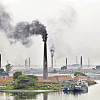Real-time air quality tracking launched across Bangladesh

The government has recently launched a 'real-time air quality index' program, which will provide up-to-the-minute information on the air quality across the country. The initiative, led by the Department of Environment, aims to inform the public about the health implications of varying pollution levels while fostering proactive measures to control and mitigate air pollution.
The real-time air quality index system was inaugurated by Md. Mahbub Hossain, Cabinet Secretary of Bangladesh, on November 19, during a meeting of the National Committee on Air Pollution Control. There, it was revealed that the air quality data will be automatically analysed from 16 Continuous Air Monitoring Stations (CAMS) across Bangladesh, operated by the Department of Environment.
The CAMS will continuously monitor six air pollutants - PM 10, PM 2.5, ozone, sulfur dioxide, nitrogen oxides, and carbon monoxide. The Air Quality Index (AQI) values will categorise air quality into different levels to help people understand the health implications of air pollution.
The following categories are used to group AQI readings based on the impact of air pollution on human health, ranging from 0 to over 300. An AQI reading of 0 to 50 is considered 'good', i.e. air quality is considered satisfactory and air pollution poses little or no risk. From 51 to 100, it's 'moderate', i.e. acceptable air quality; from 101 to 150 it's 'unhealthy' for sensitive groups, i.e. individuals with respiratory or heart conditions; from 151 to 200 it's 'unhealthy' for the general population; from 201 to 300 it's 'very unhealthy', i.e. everyone may experience more serious health effects; and finally, 301 and above, is considered 'hazardous', i.e. health warnings of emergency conditions.
The Air Quality Index (AQI) from the new system will be calculated and published on the Department of Environment's public website. The real-time automated method will utilise data from the aforementioned CAMS located in various regions, including Dhaka, Agargaon, BARC of Farmgate, Darus Salaam, Savar, Gazipur, Narayanganj, Mymensingh, Agrabad of Chittagong, Sylhet, Cumilla, Rangpur, Chittagong, Rajshahi, Barisal, Khulna, and Narsingdi.

 For all latest news, follow The Daily Star's Google News channel.
For all latest news, follow The Daily Star's Google News channel. 








Comments